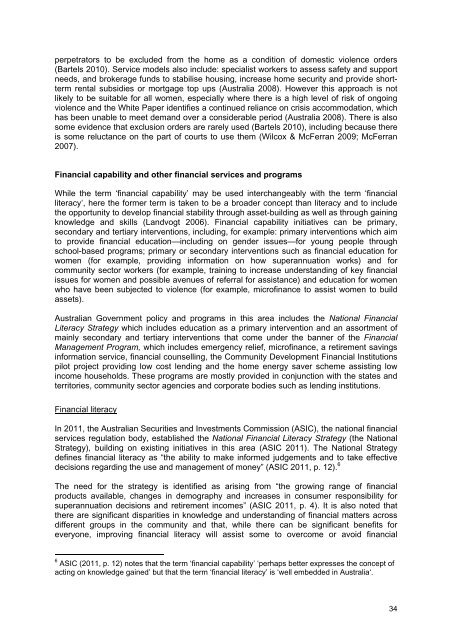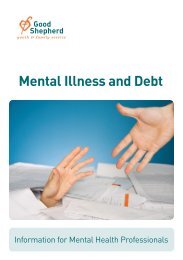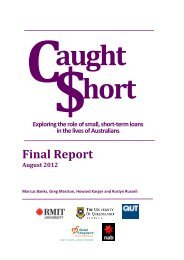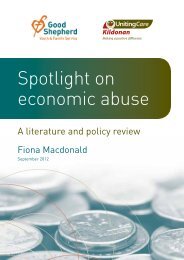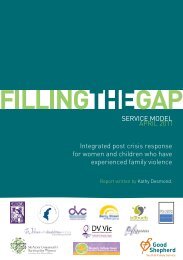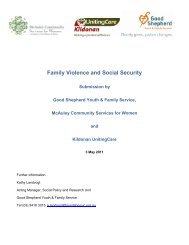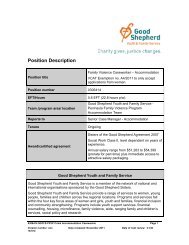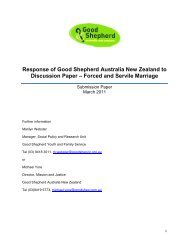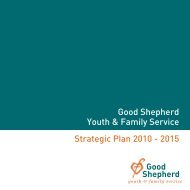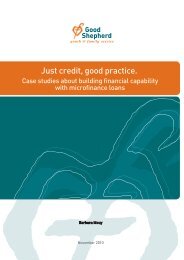Spotlight on economic abuse - Good Shepherd Youth & Family ...
Spotlight on economic abuse - Good Shepherd Youth & Family ...
Spotlight on economic abuse - Good Shepherd Youth & Family ...
You also want an ePaper? Increase the reach of your titles
YUMPU automatically turns print PDFs into web optimized ePapers that Google loves.
perpetrators to be excluded from the home as a c<strong>on</strong>diti<strong>on</strong> of domestic violence orders<br />
(Bartels 2010). Service models also include: specialist workers to assess safety and support<br />
needs, and brokerage funds to stabilise housing, increase home security and provide shortterm<br />
rental subsidies or mortgage top ups (Australia 2008). However this approach is not<br />
likely to be suitable for all women, especially where there is a high level of risk of <strong>on</strong>going<br />
violence and the White Paper identifies a c<strong>on</strong>tinued reliance <strong>on</strong> crisis accommodati<strong>on</strong>, which<br />
has been unable to meet demand over a c<strong>on</strong>siderable period (Australia 2008). There is also<br />
some evidence that exclusi<strong>on</strong> orders are rarely used (Bartels 2010), including because there<br />
is some reluctance <strong>on</strong> the part of courts to use them (Wilcox & McFerran 2009; McFerran<br />
2007).<br />
Financial capability and other financial services and programs<br />
While the term ‘financial capability’ may be used interchangeably with the term ‘financial<br />
literacy’, here the former term is taken to be a broader c<strong>on</strong>cept than literacy and to include<br />
the opportunity to develop financial stability through asset-building as well as through gaining<br />
knowledge and skills (Landvogt 2006). Financial capability initiatives can be primary,<br />
sec<strong>on</strong>dary and tertiary interventi<strong>on</strong>s, including, for example: primary interventi<strong>on</strong>s which aim<br />
to provide financial educati<strong>on</strong>—including <strong>on</strong> gender issues—for young people through<br />
school-based programs; primary or sec<strong>on</strong>dary interventi<strong>on</strong>s such as financial educati<strong>on</strong> for<br />
women (for example, providing informati<strong>on</strong> <strong>on</strong> how superannuati<strong>on</strong> works) and for<br />
community sector workers (for example, training to increase understanding of key financial<br />
issues for women and possible avenues of referral for assistance) and educati<strong>on</strong> for women<br />
who have been subjected to violence (for example, microfinance to assist women to build<br />
assets).<br />
Australian Government policy and programs in this area includes the Nati<strong>on</strong>al Financial<br />
Literacy Strategy which includes educati<strong>on</strong> as a primary interventi<strong>on</strong> and an assortment of<br />
mainly sec<strong>on</strong>dary and tertiary interventi<strong>on</strong>s that come under the banner of the Financial<br />
Management Program, which includes emergency relief, microfinance, a retirement savings<br />
informati<strong>on</strong> service, financial counselling, the Community Development Financial Instituti<strong>on</strong>s<br />
pilot project providing low cost lending and the home energy saver scheme assisting low<br />
income households. These programs are mostly provided in c<strong>on</strong>juncti<strong>on</strong> with the states and<br />
territories, community sector agencies and corporate bodies such as lending instituti<strong>on</strong>s.<br />
Financial literacy<br />
In 2011, the Australian Securities and Investments Commissi<strong>on</strong> (ASIC), the nati<strong>on</strong>al financial<br />
services regulati<strong>on</strong> body, established the Nati<strong>on</strong>al Financial Literacy Strategy (the Nati<strong>on</strong>al<br />
Strategy), building <strong>on</strong> existing initiatives in this area (ASIC 2011). The Nati<strong>on</strong>al Strategy<br />
defines financial literacy as “the ability to make informed judgements and to take effective<br />
decisi<strong>on</strong>s regarding the use and management of m<strong>on</strong>ey” (ASIC 2011, p. 12). 6<br />
The need for the strategy is identified as arising from “the growing range of financial<br />
products available, changes in demography and increases in c<strong>on</strong>sumer resp<strong>on</strong>sibility for<br />
superannuati<strong>on</strong> decisi<strong>on</strong>s and retirement incomes” (ASIC 2011, p. 4). It is also noted that<br />
there are significant disparities in knowledge and understanding of financial matters across<br />
different groups in the community and that, while there can be significant benefits for<br />
every<strong>on</strong>e, improving financial literacy will assist some to overcome or avoid financial<br />
6 ASIC (2011, p. 12) notes that the term ‘financial capability’ ‘perhaps better expresses the c<strong>on</strong>cept of<br />
acting <strong>on</strong> knowledge gained’ but that the term ‘financial literacy’ is ‘well embedded in Australia‘.<br />
34


